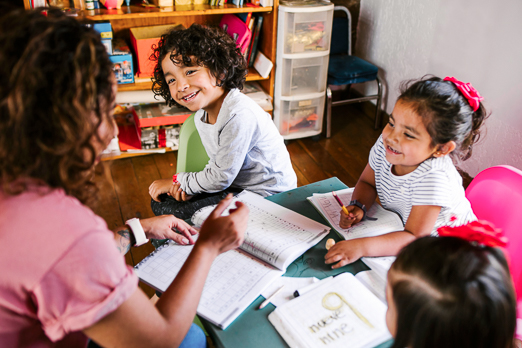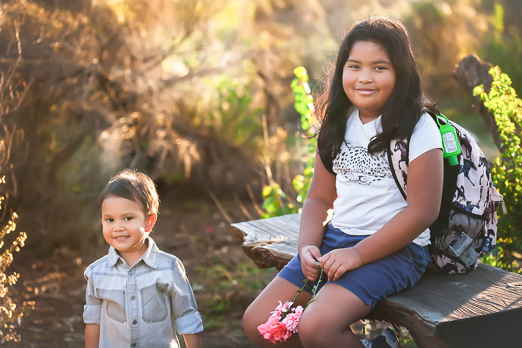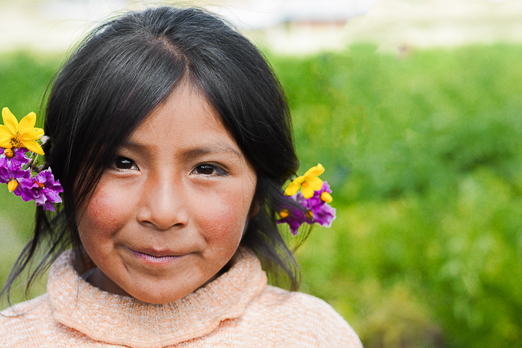This page provides a brief introduction to the histories, traditions, and cultures of ethnic and racial minority groups in the United States. The information here is by no means comprehensive, and we encourage you to learn more about the unique and diverse experiences of all people in the United States and beyond. Also consider the concept of intersectionality, the way in which one’s multiple identities (gender, race, class, religion, sexual orientation, etc.) interact with each other and with the larger society. For example, how might the experiences of a mixed-race student differ from that of a student who identifies with one racial group? We hope this page provides you with helpful information that will ultimately help you better engage with and understand the individual students you teach.
Jump to:
- Black & African American
- Asian & Asian American
- Hispanic & Latino
- Pacific Islander & Native Hawaiian
- American Indian & Alaska Native
Black & African American

Individuals of African origin comprise approximately 13.7% of the population in the United States. The term African American refers to individuals who are residents of the United States, usually raised here, and who are of African ancestry, whereas the term Black is more general and can refer to anyone of African ancestry, including recent immigrants.
History & Background
The ancestors of many contemporary Black Americans were enslaved and brought to the Americas against their will. People such as Nat Turner, a preacher who led the most significant slave uprising in American history; Harriet Tubman, a prominent leader of the Underground Railroad; and Harriet Beecher Stowe, author of Uncle Tom's Cabin, helped to fight against slavery.
Even after ratification of the Thirteenth and Fourteenth Amendments, which prohibited slavery and granted United States citizenship to African Americans, segregation laws (such as Black Codes or Jim Crow laws) and acts of violence continued—restricting African Americans from voting or taking active roles in their citizenship. It was not until 1954 that segregation in public schools was deemed unconstitutional (see Brown v. Board of Education of Topeka).
Through organizations such as the NAACP, and with the inspiration of people such as Booker T. Washington, Jackie Robinson, Rosa Parks, Malcolm X, and Martin Luther King, Jr., the rights and freedoms of African Americans have increasingly improved in the United States.
Culture & Traditions
African cultures are represented in many forms of music, dance, art, and storytelling. With more than 1,000 languages spoken and many different religions and tribes, Africa is rich in cultural diversity. African American homes also have remarkable diversity, with notable differences across regions of the U.S. Families often include immediate and extended relatives, with a group-oriented worldview and a strong sense of shared community. For this and other cultures that value a lifestyle of cooperation and sharing, activities that involve tactile learning and cooperative grouping may be particularly effective, as they parallel the context for learning found in the cultures.
Celebrating Black Heritage
Black History Month, observed each February in the United States, celebrates the achievements, culture, and contributions of African Americans. The month was chosen to coincide with the birthdays of Frederick Douglass and Abraham Lincoln, two key figures in the fight for freedom and equality.
Resources
- National Association of the Advancement of Colored People
- African American Resources for Educators
- African American Music and Culture
- Information on African Americans
Asian & Asian American

Asian Americans comprise 6.4% of the U.S. population and are the fastest-growing racial group in the United States. They are highly diverse, including dozens of ethnicities and languages; these include individuals with Chinese, Japanese, Korean, Indian, Laotian, Filipino, Thai, and Vietnamese ancestry.
History & Background
The first Asians to settle in the United States were Chinese Filipinos, who had originally migrated to Mexico then moved to what is now Louisiana. Beginning in the 1840s, increasing numbers of Chinese workers immigrated to the western United States, as well as Japanese, Koreans, and Filipinos to Hawaii. These early immigrant laborers experienced persecution and violence and were not granted citizenship, even if their children were born in the United States. This exclusion caused them to form their own communities where they could be self-sufficient. Conditions for Asians in the United States did not improve dramatically until after World War II, after thousands of Japanese Americans were released from the internment camps in which they had been forced to live. During the 1970s and 1980s, immigration increased from Southeast Asia following the Vietnam War.
Culture & Traditions
Asian Americans commonly face challenges in establishing cultural identity, especially second-generation immigrants who struggle to balance traditional cultural ideas with the pressure of assimilating into American cultural society. When working with individuals of Asian ancestry, educators need to understand three of the main Eastern philosophies and their impact on Asian culture: Buddhism, Confucianism, and Taoism. Within these philosophies, families are highly structured, hierarchical, and patriarchal. Within the family systems, children are taught that they must avoid bringing shame to their family and that the welfare and integrity of the family are very important. These Asian philosophies also teach principles of peace, balance, and harmony, causing some Asians to avoid confrontation or to appear passive, indifferent, or indecisive. For some Asian students with strong ties to their family culture, using indirect methods of communication may be appropriate.
Celebrating Asian Heritage
Asian American and Pacific Islander Heritage Month, celebrated each May, honors the history, culture, and contributions of Asian Americans and Pacific Islanders in the United States. The month of may was chosen to celebrate the anniversary of the first asian american immigrants arriving on May 7, 1843.
Resources
Hispanic & Latino

In 2022, Latinos accounted for 28.9% of the U.S. K–12 population. Although many children adapt to new environments more easily than adults, they experience difficulties from multiple pressures. Knowledge of acculturation processes and dilemmas are therefore essential to working with children who have relocated recently. Useful information includes familiarity with concepts of familismo (close family ties), personalismo (people-centered living), and simpatía (easy-going, pleasant personal qualities).
History & Background
Long before English immigrants came to North America, the Spanish had explored, settled, and claimed lands such as California and Florida. The United States later annexed lands claimed by Mexico that are present-day Texas, New Mexico, Arizona, Utah, and California.
Individuals of Latin American origin comprise 19.5% of the population of the United States, and this ethnic group is the fastest-growing in Utah and surrounding states. Much attention has been focused on new waves of immigrants, but professionals need to be aware of the wide variety of needs and experiences across different Latino subpopulations.
Culture & Traditions
The term Hispanic is used in the United States to describe all people of Latino and Spanish descent. It is a broad ethnic classification of people originating from over 20 countries in Central and South America. Educators need to account for diversity among Hispanic students.
The family is the nucleus of Hispanic life. Involving the family as much as possible in the education process will not only help the student but will also increase the likelihood of future educational success among all family members. Many Hispanic students are bilingual. If they are not proficient in their native language or the language spoken at home, they may have difficulty with English language skills or reading comprehension in school. Teachers should encourage increasing English skills through bilingual education programs or methods, understanding that true bilingualism means being proficient in both English and the native language.
Educators should also understand and respect cultural differences. For example, Hispanics tend to have closer personal space and value physical contact. Appearance and group memberships are very important. Latinos will work hard for the goals of a group and will work hard for the needs of the community. Educators can better serve their Latino students when they learn about and accommodate their cultural heritage and ways of interacting with others.
Celebrating Hispanic Heritage
National Hispanic Heritage Month runs from September 15 to October 15 every year, and it is a time dedicated to celebrating the histories, cultures, and contributions of Hispanic Americans. September 15 is significant because it marks independence days for Costa Rica, El Salvador, Guatemala, Honduras, and Nicaragua.
Resources
Pacific Islander & Native Hawaiian

Pacific Islanders encompass a wide range of cultural groups and nationalities from Oceania, a geographical region that includes Polynesia, Melanesia, and Micronesia. Polynesia consists of several groups of islands forming a triangle including Hawaii, the Easter Islands, New Zealand, Tonga, and Samoa. Melanesia includes Fiji, Papua New Guinea, the Solomon Islands, Vanuatu Islands, and New Caledonia. Micronesia is divided into eight territories, which include Guam, Kiribati, and the Marshall Islands.
History & Background
European explorers, including Captain James Cook, sailed to the Polynesian Islands during the 17th and 18th centuries. Shortly thereafter, missionaries went to the islands preaching and converting Polynesians to Christianity. Soon Europe and America were claiming political power over these islands, overthrowing the islands' individual monarchies. However, some traditional monarchies (e.g., Tonga) still thrive today.
Culture & Traditions
Pacific Islanders live a very social lifestyle, in which family members—both immediate and extended—work together in a unified community. Pacific Islanders' cultures follow customs and traditions based on ancient principles that promote living an honorable and noble lifestyle. Embedded deeply into the Polynesian culture are traditional music, dance, and food. Storytelling, music, and dance are ancient ways of passing down history from one generation to another. Thus, teachers with Pacific Islander students may want to use both written and oral instruction, particularly in areas of literacy.
Celebrating Pacific Islander and Native Hawaiian Heritage
Pacific Islander and Native Hawaiian Heritage Month, observed each May, celebrates the history, culture, and contributions of Pacific Islanders and Native Hawaiians in the United States.
Resources
American Indian & Alaska Native

Native Americans, the indigenous peoples of the United States, currently comprise 1.3% of the population. The culture and traditions of Native Americans have been a source of support and healing for them in contemporary society, and educators will benefit from understanding the distinctive backgrounds and heritages of their Native American students.
History & Background
Each tribe has its own unique history. Increasingly, those histories are being related in public schools. For example, stories of the pilgrims settling New England are now intermixed with stories of Squanto and others teaching New England settlers how to build warm houses, plant crops, and adapt to the new environment. Accounts of explorations of the West now recognize not only how Sacagawea helped Lewis and Clark, but also how native peoples were betrayed during decades of encroachment and violence. When teaching about WWII, some teachers recognize the unique contributions of Native Americans, such as the Navajo Code Talkers, who used their native language to effectively transmit messages the enemies could not decode.
Native Americans are gaining increased representation and political power. The Indian Reorganization Act of 1934, often called the "Indian New Deal," established new rights for Native American nations, allowing them limited sovereignty and presenting them with new roads, health care, and education. Civil liberties have gradually increased since that time, although the legacy of past oppression continues to have effects that should not be minimized.
Culture & Traditions
More than 500 Native American tribes are recognized in the United States. While there are similarities among tribal heritages and traditions, Native American culture varies from nation to nation. Furthermore, the culture of Native Americans living on reservations differs greatly from that of Native Americans who live elsewhere.
What is specifically characteristic of Native American culture? There is no single answer to this question. As educators develop lesson plans about Native American culture, they must keep in mind that each tribe holds its own traditions and way of life. Often media and books tend to inappropriately generalize all Native Americans. Teaching specific information about different tribes helps to depict the Native American culture more accurately. Educators may want to consider incorporating cooperative learning, focusing on building strong relationships of trust and using real-life examples to illustrate the importance of classroom material.
Celebrating American Indian & Alaska Native Heritage
American Indian and Alaska Native Heritage Month, celebrated each November, honors the history, culture, and contributions of Indigenous peoples in the United States. November was chosen as it aligns with traditional harvest seasons and a time of reflection for many Native communities.